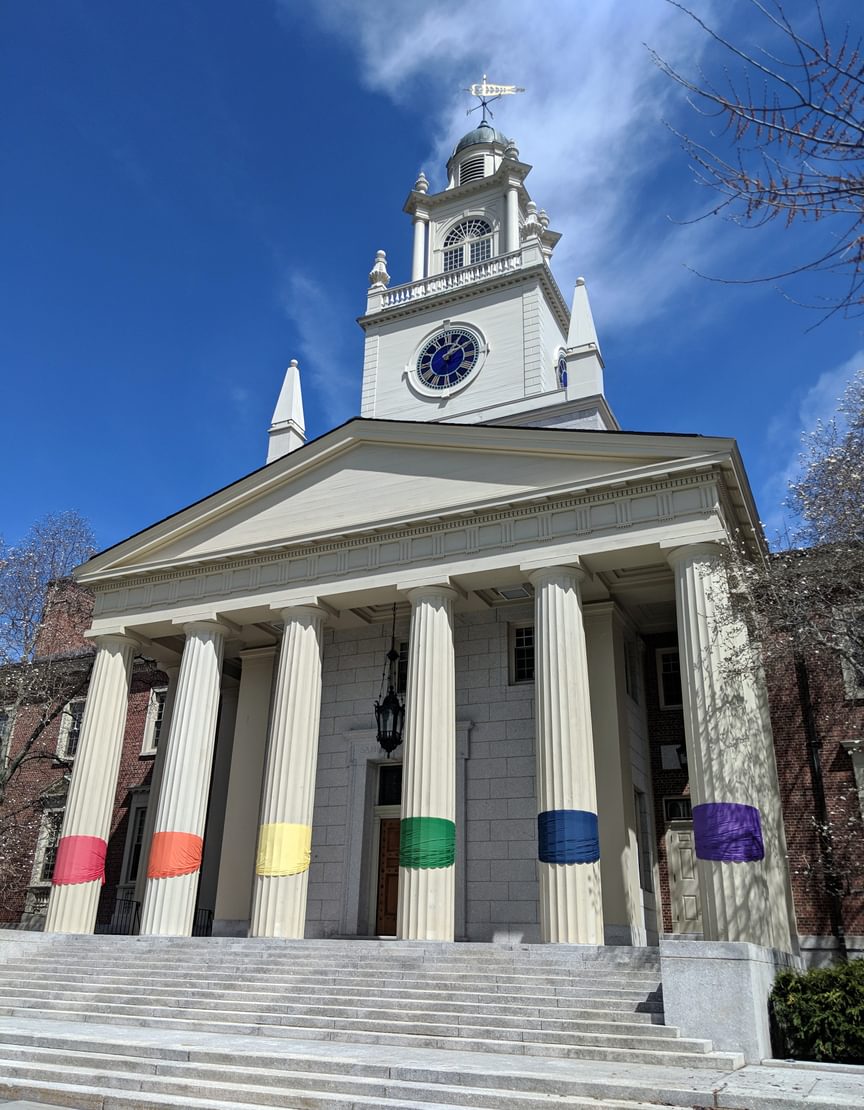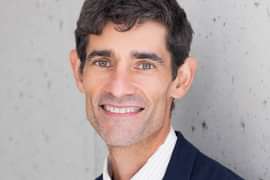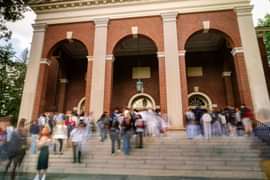
July 19, 2019
Points of pride
The Gender and Sexuality Alliance had no model to emulate when it began at Andover 30 years agoby Sharon Tentarelli ’90
Now a presence at schools across the country, the Gender and Sexuality Alliance had no model to emulate when it began 30 years ago at Andover. Thanks to the courage of student and faculty changemakers, the GSA blazed a trail for advocacy, education, and community building around human rights for LGBTQ+ students, faculty, and staff at PA.
In the late 1980s, daily notices printed on blue paper were commonly posted on bulletin boards all over campus. The signs captured a cross-section of administrative information and student activities. On February 7, 1989, students were reminded to check the winter trimester exam schedule, that they could get warts checked out at a dermatology clinic or buy carnations for Valentine’s Day. But one item, with the eye-catching subject “GAY RIGHTS,” stood out. It announced a meeting that evening for a discussion of gay rights, sexual preference, and related topics. All were welcome.
The previous year, following a controversy about the senior class trip, the Class of 1988 held a meeting to wrestle with topics of racism, sexism, and elitism. Shaun McCarthy ’88 came out as gay at that meeting, and his courageous statements about how that affected his experiences and treatment at Andover resulted in weeks of further awkward conversations throughout the school. After Shaun graduated, there were no publicly out students at Andover.
I had only come out as a lesbian to a few close friends, but I had heard the oft-quoted statistic that one in 10 people is gay, lesbian, or bisexual and—in a school of over 1,200 students—I knew there had to be others besides me. So in early 1989, desperate to find kindred spirits, I decided to start a group where lesbian, gay, and bisexual students, plus straight allies, could develop a supportive community for ourselves.
Cilla Bonney-Smith, the school counselor and associate dean of residence who led AIDS education efforts, seemed like the perfect administrator to approach for help. Not only was she willing to say the word “gay” in public, she was also married to a male math teacher and she looked and dressed like everybody’s middle-aged mom. She could also sponsor the group as a straight ally, which was somewhat less of a professional risk. Cilla agreed to help and reserved a conference room for our first meeting.
We had no idea what to expect that first night. Would anyone show up? Would anyone show up to object to it? We had a few blurry photocopies of information to use as discussion points; would that lead anywhere useful?
The dozen or so people who came that night—students and faculty, gay and lesbian and bisexual and straight—could not have imagined we would start an organization that is still going strong 30 years later. What we did know, after talking through the blurry photocopies and moving on to a free-wheeling discussion and supportive laughter, was that we were creating something important and valuable.
The Gay-Straight Alliance, later renamed the Gender and Sexuality Alliance, has now been a thriving and supportive organization for a full generation of Andover students.
Andover’s GSA was only the third such high school group in this country when it began, and in those early pre-internet days, everything we did was uncharted territory. We continued with our weekly meetings, having discussions and occasionally watching movies. By late spring, when The Phillipian produced its annual “Relationships” issue, we were visible enough to warrant the headline “Homosexuals and Bisexuals Struggle to Find a Place.” The article encouraged awareness, tolerance, and acceptance. That autumn, we took our activism off campus, joining a Massachusetts State House rally advocating for gay and lesbian couples to be foster parents. In the spring of 1990, we held the first “Gay Awareness Week,” with a series of talks, movies, and biographies about famous gay people posted around campus.
Reactions to the GSA were mixed in those early years. Students who were uncomfortable with the group tended to ignore direct confrontations, though muttered comments were common. A spoof “Exonian” issue of The Phillipian showed that homophobia, along with racism and sexism, was still quite prevalent though many students were willing to grapple with the problem. The administration was dealing with the GSA in its own ways, but Cilla Bonney-Smith and teachers like Nancy Boutilier and Tony Rotundo were successful in keeping students mostly insulated from administrative pushback, and Headmaster Don McNemar ultimately went from wary to supportive.
Over the decades since its founding, the GSA has evolved to become even more inclusive, as has the campus environment as a whole. Transgender people weren’t even on the GSA’s radar in 1989, but in recent years Andover has become more inclusive and accepting of students whose gender identity or gender expression may differ from binary cisgender norms. Karissa Kang ’17 worked on a Brace fellowship research project, which led to the opening of Andover’s first all-gender dorm in 2018. And a recent awareness campaign around PGPs (preferred gender pronouns) has led to more openness and inclusive language use. Since 1999, same-sex faculty couples have been allowed to serve as house counselors, which is critical for professional equality and provides valuable diversity in terms of adult resources and role models. On a lighter note, the drag show performed in April as part of the 30th anniversary celebration drew over 300 attendees for an uproarious, outrageously fun evening.
I’ve returned to Andover several times over the decades to celebrate various milestone anniversaries with the GSA. Each time, I have been struck by how some issues remain the same. Showing the students the front page of The Phillipian’s “Relationships” issue from 1989, they marvel at how many articles still relate to campus life today: students still want sex education and birth control, interracial dating is still complicated, guys and girls still differ in what they find attractive about each other, and nobody quite wants to ask how that works for the homosexuals and bisexuals who are still struggling to find their place.
Throughout all of these changes (and similarities) students still find the GSA to be supportive and serious, fun and celebratory. The GSA continues to offer a community of acceptance where it’s OK to be whoever you are, and where it’s OK to still be figuring out who you are. The GSA continues to work toward making the campus a better and more accepting environment for all.
Sharon Tentarelli ’90 is an analytical chemist who lives in Massachusetts with her wife, Ellen, and their one-eyed cat, Molly.
Alumni interested in supporting the GSA can contact Community and Multicultural Development Office Director LaShawn Springer ([email protected]) or faculty advisors Corrie Martin ([email protected]) and David Farnsworth ([email protected]).
Categories: Magazine
Other Stories

Spring 2024 issue will explore how Andover is shaping the future




